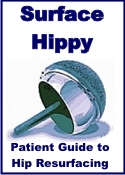|
Paid Advertisement



|
Rates of Primary Knee Replacement and Revision Surgery Up
Sharply Over the Last 20 Years in the Medicare Population
SEPTEMBER 25, 2012
CHICAGO – There has been an increase in total knee
arthroplasty (TKA; knee replacement) procedures over the past 20
years that has been driven by both an increase in the number of
Medicare enrollees and increase in per capita utilization, according
to a study in the September 26 issue of JAMA. There has also been a
decrease in hospital length of stay for TKA, but increased hospital
readmission rates and increased rates of infectious complications.
“Total knee arthroplasty is a common and safe procedure typically
performed for relief of symptoms in patients with severe knee
arthritis. Available data suggest that approximately 600,000 TKA
procedures are performed annually in the United States at a cost of
approximately $15,000 per procedure ($9 billion per year in
aggregate),” according to background information in the article.
Total knee arthroplasty is one of the most common and costly
surgical procedures performed in the United States. “Despite the
clinical and economic policy importance of TKA, there are few
analyses evaluating recent trends over time in use of and outcomes
associated with TKA.”
Peter Cram, M.D., M.B.A., of the University of Iowa Carver College
of Medicine, Iowa City, Iowa, and colleagues conducted a study to
evaluate trends in primary and revision TKA volume, per capita
utilization, and outcomes in the U.S. Medicare population for the
time period between 1991 and 2010. The analysis included 3,271,851
patients (age 65 years or older) who underwent primary TKA and
318,563 who underwent revision TKA identified in Medicare Part A
data files.
The researchers found that the number of primary TKA procedures
increased from 93,230 in 1991 to 243,802 in 2010 (an increase of
161.5 percent), while per capita utilization increased 99.2% (from
31.2 procedures per 10,000 Medicare enrollees in 1991 to 62.1
procedures per10,000 in 2010). The number of revision TKA procedures
increased from 9,650 in 1991 to 19,871 in 2010 (an increase of 105.9
percent), and per capita utilization increased 59.4 percent (from
3.2 procedures per 10,000 Medicare enrollees in 1991 to 5.1
procedures per 10,000 in 2010). Also during this time period, the
prevalence of obesity among patients undergoing primary TKA
increased from 4.0 percent to 11.5 percent. The average hospital
length of stay (LOS) for primary TKA declined from 7.9 days in
1991-1994 to 3.5 days in 2007-2010, a relative decline of 55.7
percent. All-cause 30-day readmission rates increased from 4.2
percent in 1991-1994 to 5.0 percent in 2007-2010.
“Trends in discharge disposition after revision TKA demonstrated a
similar pattern to that which was observed for primary TKA, a
decline in discharges to home or inpatient rehabilitation and an
increase in discharge to skilled care and outpatient
rehabilitation,” the authors write.
The researchers add that for revision TKA, a decrease in hospital
LOS was accompanied by an increase in all-cause 30-day readmission
from 6.1 percent to 8.9 percent and an increase in readmission for
wound infection from 1.4 percent to 3.0 percent.
“These figures suggest that growth in primary and revision TKA
volume is being driven by both an increase in the number of Medicare
enrollees and an increase in per capita arthroplasty utilization,”
the authors write. “This growth is likely driven by a combination of
factors including an expansion in the types of patients considered
likely to benefit from TKA, an aging population, and an increasing
prevalence of certain conditions that predispose patients to
osteoarthritis, most notably obesity.”
“The growth in TKA should prompt consideration of whether too many
(or too few) of these procedures are being performed both in
aggregate and among key patient subgroups defined by race, sex, or
age.”
(JAMA. 2012;308[12]:1227-1236)
Editor’s Note: This work is funded in-part by grants from the NHLBI
and from the NIA. Please see the article for additional information,
including other authors, author contributions and affiliations,
financial disclosures, etc.
Editorial: Increasing Use of Total Knee Replacement and Revision
Surgery
James Slover, M.D., M.S., and Joseph D. Zuckerman, M.D., of the
Hospital for Joint Diseases of New York University Langone Medical
Center, New York, comment on the findings of this study in an
accompanying editorial.
|
|